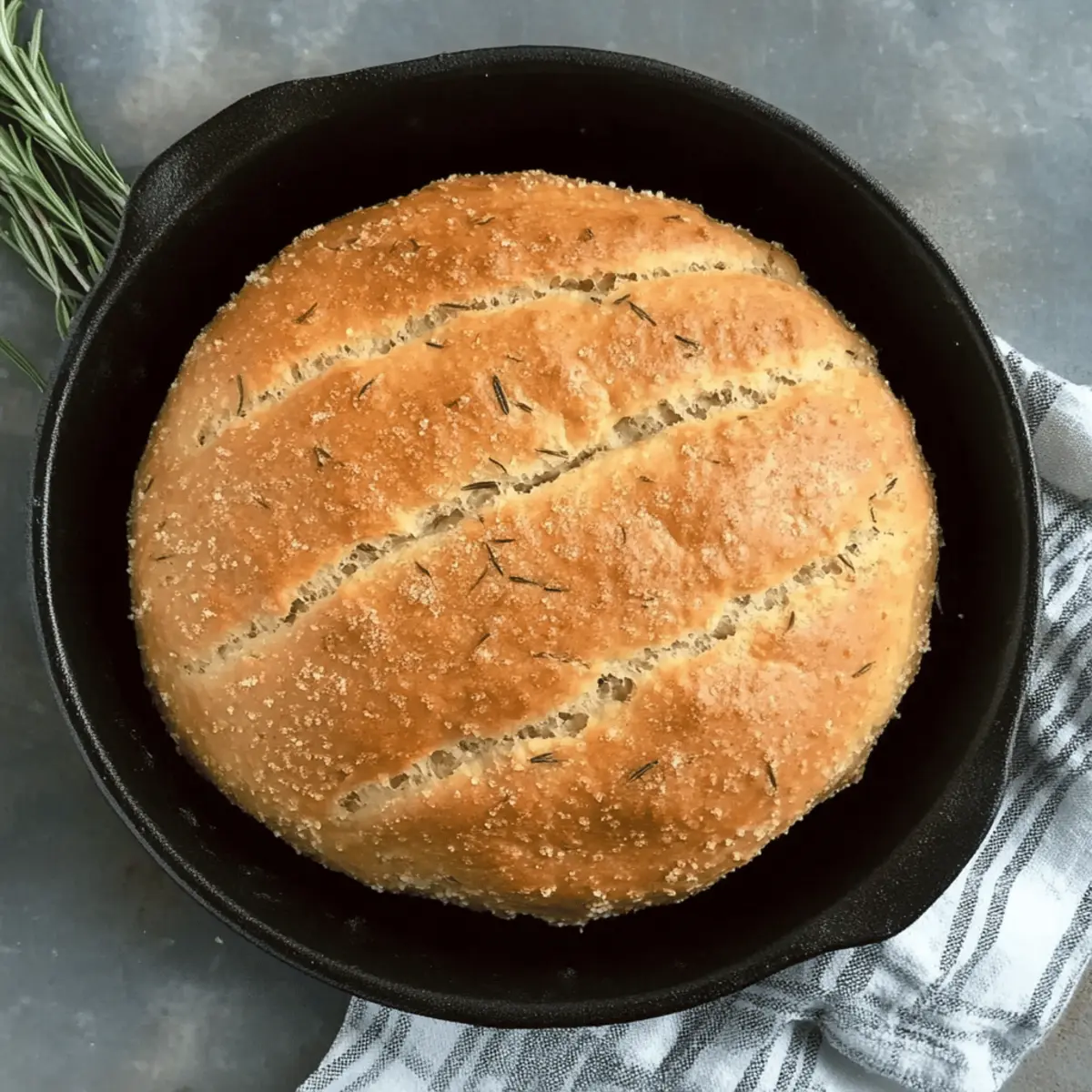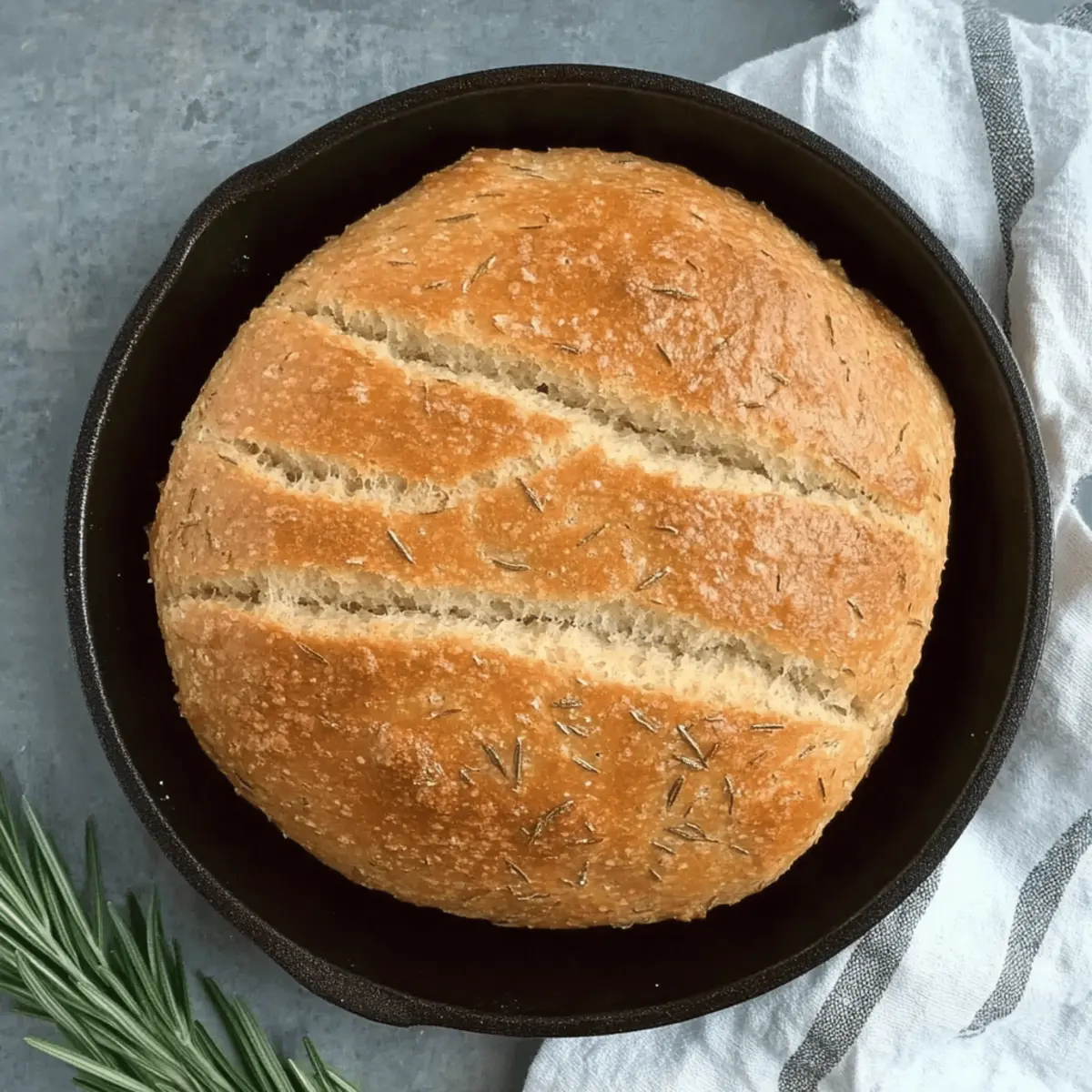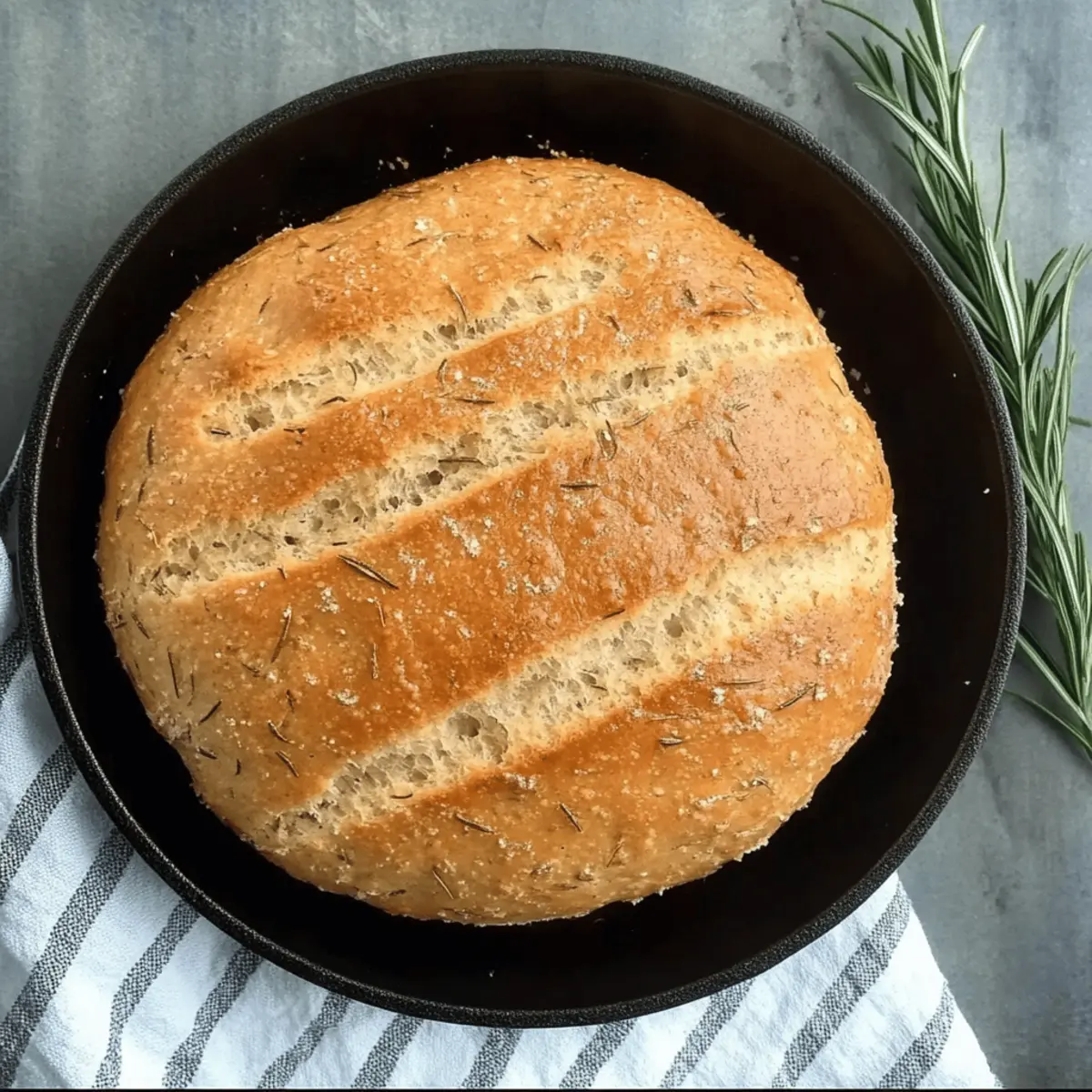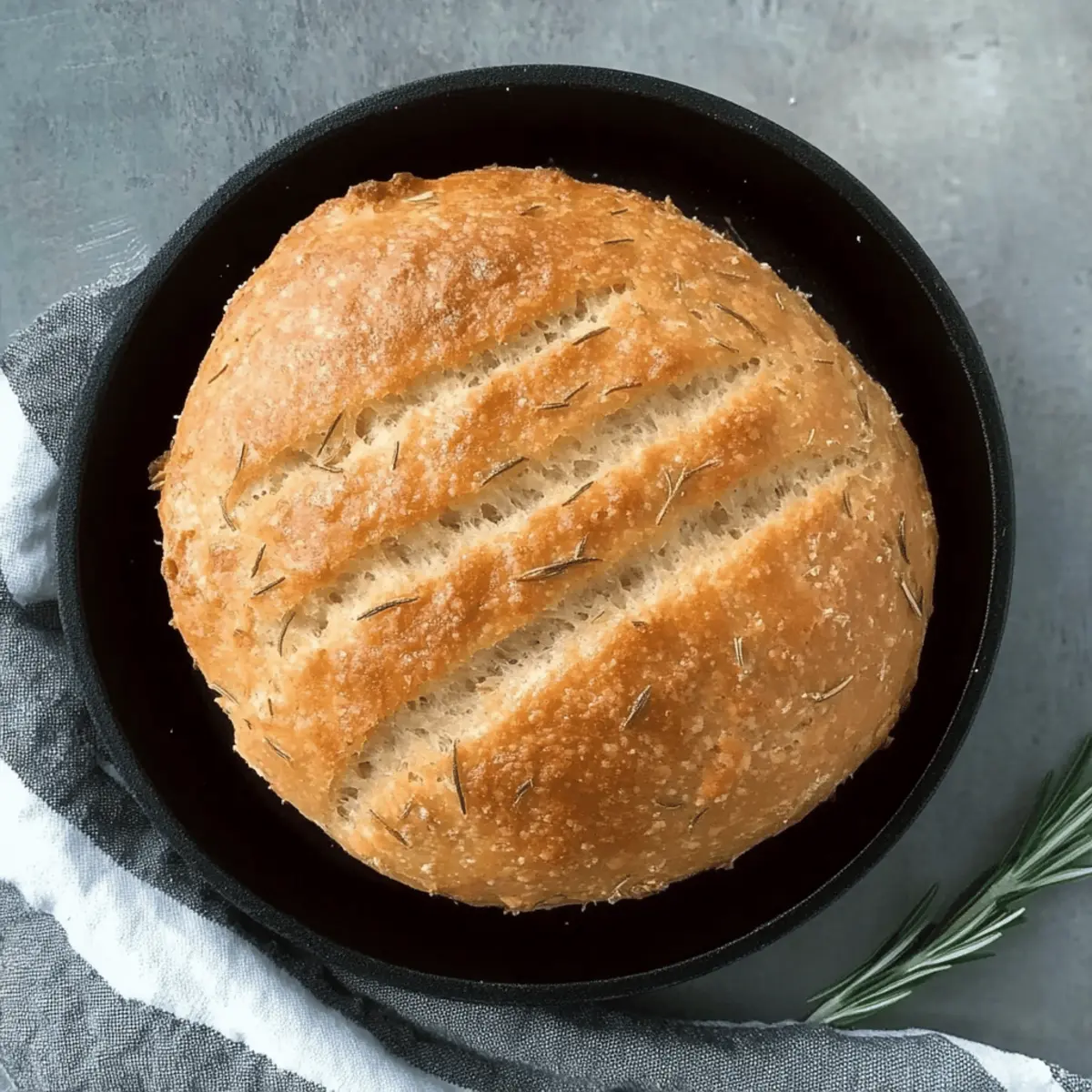The enticing aroma of fresh rosemary wafting through my kitchen is a scent that instantly transports me to a sunny Mediterranean market. Today, I’m thrilled to share my recipe for Fluffy Gluten-Free Rosemary Olive Oil Bread—an absolute game-changer for anyone seeking a delicious gluten-free option. This bread’s unique combination of earthy rosemary and rich olive oil not only makes it a delightful companion for soups and salads but also perfect for sandwiches or simply enjoyed on its own. With quick prep and a tender, airy texture, this recipe proves that gluten-free doesn’t mean compromising on flavor. Are you ready to join me in baking this delightful loaf? Your kitchen is about to smell amazing!

Why is This Bread So Special?
Fluffy Texture: This Rosemary Olive Oil Bread boasts a soft, airy crumb, making it perfectly delightful for sandwiches or a cozy snack.
Herbaceous Aroma: Infused with fresh rosemary, it delivers an enchanting scent that elevates your kitchen and dining experience.
Versatile Pairing: Whether served with hummus or drizzled with olive oil and balsamic vinegar, its flavor shines with any meal.
Quick and Simple: With straightforward steps and minimal prep, you’ll have homemade bread in no time, perfect for busy weeknights.
Healthier Option: Enjoy a guilt-free indulgence that’s lower in carbs and packed with heart-healthy fats from olive oil, making it a wholesome choice.
You’ll absolutely love how this bread brings together convenience and flavor, transforming your gluten-free baking adventures! Don’t forget to save some for your next meal alongside a warm bowl of soup or salad!
Rosemary Olive Oil Bread Ingredients
Here’s everything you need to create this delightful loaf!
For the Bread
- Gluten-Free Flour Blend – Ensure it contains binding agents to give the bread structure and texture.
- Fresh Rosemary – Use finely chopped for even flavor distribution that complements the bread beautifully.
- Olive Oil – Extra virgin is preferred, as it contributes essential richness and moisture to the loaf.
- Active Dry Yeast – Check for freshness to achieve that perfect fluffy texture in your gluten-free bread.
- Honey (or Sugar) – Activates the yeast with a hint of sweetness; maple syrup can be used for a vegan alternative.
- Warm Water – Temperature is key; aim for around 110°F/43°C to properly activate the yeast.
- Salt – This little ingredient enhances flavor and helps strengthen the dough structure.
- Apple Cider Vinegar (optional) – A little splash improves texture and adds depth to the flavor profile.
- Garlic Powder (optional) – Introduces a subtle depth; a wonderful enhancement if you love a hint of garlic!
- Chopped Olives (optional) – Adds a Mediterranean twist and boosts the flavor profile delightfully.
Dive into your baking adventure with these ingredients, and prepare for the mouthwatering aromas that will fill your kitchen as your Rosemary Olive Oil Bread is baking!
Step‑by‑Step Instructions for Rosemary Olive Oil Bread
Step 1: Activate the Yeast
In a small bowl, combine 1 cup of warm water (around 110°F/43°C), 1 tablespoon of honey (or sugar), and 2 teaspoons of active dry yeast. Stir gently and let it sit for 5-10 minutes until it becomes foamy. This step ensures your yeast is activated, which is crucial for creating a fluffy texture in your Rosemary Olive Oil Bread.
Step 2: Mix the Dough
In a large mixing bowl, whisk together 3 cups of gluten-free flour blend, 2 tablespoons of finely chopped fresh rosemary, 1 teaspoon of salt, and optional garlic powder for added flavor. Create a well in the center, then pour in the foamy yeast mixture along with 3 tablespoons of olive oil. Mix everything until a sticky dough forms, ensuring all ingredients are well incorporated.
Step 3: Knead and Rest
Lightly knead the dough in the bowl for about 2-3 minutes until it begins to smooth out. Then, cover the bowl with a clean kitchen towel or plastic wrap, and place it in a warm area to rise. Allow it to rest for 1-1.5 hours, or until it has slightly increased in volume, which is essential for the bread’s texture.
Step 4: Shape the Dough
Once risen, gently punch down the dough to release any air bubbles. Grease a loaf pan or line a baking sheet with parchment paper. Transfer the dough onto a clean surface and shape it into a loaf or desired form. Place the dough into the prepared pan, scoring the top with a knife if you like, to create decorative slashes.
Step 5: Bake the Bread
Preheat your oven to 375°F (190°C). Once preheated, place the shaped dough in the oven and bake for 30-40 minutes. You’ll know it’s done when the bread is golden brown and sounds hollow when tapped on the bottom. This step helps achieve that delightful crust on your Rosemary Olive Oil Bread.
Step 6: Cool and Serve
After baking, carefully remove the bread from the oven and let it cool in the pan for about 10 minutes. Then, transfer it to a wire rack to cool completely. Once cooled, slice the loaf and serve warm, or enjoy it later as a tasty accompaniment to your favorite meals.

Variations & Substitutions for Rosemary Olive Oil Bread
Feel free to explore these creative twists and make this recipe your own!
-
Herb Swap: Replace rosemary with thyme or oregano for a new flavor experience that still celebrates those fresh herb notes.
The possibilities of fresh herbs are plentiful! Each one brings its unique aroma, offering a delightful change from the original. -
Mediterranean Twist: Add chopped sun-dried tomatoes into the dough for a burst of flavor that pairs exquisitely with the bread’s natural richness.
These tangy bites will elevate your loaf and bring an authentic Mediterranean vibe to your table. -
Nutty Crunch: Toss in a handful of seeds or nuts, like sunflower seeds or walnuts, to provide texture and a delightful crunch.
The added crunch adds an interesting contrast to the soft and tender bread, perfect for those who love a little extra bite! -
Cheesy Goodness: Incorporate some feta or goat cheese into the dough for a savory twist that pairs beautifully with the olive oil.
Rich and creamy, cheese will melt beautifully during baking, creating pockets of indulgent flavor. -
Garlic Infusion: Mix in roasted garlic or increase the garlic powder for a deeper flavor boost that garlic lovers will adore.
With that warm aroma, this option promises to wrap your kitchen in tantalizing scents as the bread bakes. -
Vegan Alternative: Substitute honey with maple syrup to keep it vegan while maintaining that sweet touch needed for the yeast to activate.
This straightforward swap keeps the bread delicious without compromising your dietary choices. -
Spicy Kick: Add a pinch of red pepper flakes or some chopped jalapeños for a spicy kick that balances beautifully with the savory bread.
A little heat goes a long way here, giving each slice a fun twist that will delight your taste buds! -
Olive Surprise: Fold in chopped olives for a briny flavor that enhances the Mediterranean profile of your bread.
With this variation, you get a delightful pop of flavor in every bite, perfect for serving alongside dips or spreads like hummus or olive oil!
Feel inspired yet? Customize your Rosemary Olive Oil Bread to suit your taste and enjoy a fresh twist every time! For serving suggestions, consider pairing it with a vibrant Olive Garden Green sangria for an exquisite meal experience!
How to Store and Freeze Rosemary Olive Oil Bread
Room Temperature: Store the bread in an airtight container at room temperature for up to 3 days to maintain its soft texture and flavor.
Freezer: For longer storage, slice the bread and freeze. Wrap slices tightly in plastic wrap and then in aluminum foil; it will keep for up to 3 months.
Thawing: To enjoy frozen Rosemary Olive Oil Bread, simply remove the desired portion from the freezer and let it thaw at room temperature. Toast slices for a delightful crunch!
Reheating: If you prefer warm bread, reheat individual slices in the toaster or microwave. For the whole loaf, wrap it in foil and warm in a 350°F (175°C) oven until heated through.
Expert Tips for Rosemary Olive Oil Bread
-
Quality Flour Matters: Use a gluten-free flour blend that includes binding agents like xanthan or guar gum for the best texture. This ensures your Rosemary Olive Oil Bread rises beautifully!
-
Proper Yeast Activation: Always check your yeast for freshness. The foamy mixture indicates it’s active; if it doesn’t bubble, you may need to start over with fresh yeast.
-
Don’t Rush the Rise: Gluten-free dough typically rises less than traditional dough. Allow it enough time to rise, roughly 1-1.5 hours, for a fluffy crumb.
-
Olive Oil Is Key: Don’t skip or reduce the olive oil; it provides essential moisture and flavor. Extra virgin olive oil enhances the taste significantly.
-
Monitor Baking Time: Keep an eye on your bread as it bakes. Testing for a hollow sound when tapped will help you avoid overbaking, allowing that perfect crust to form.
What to Serve with Fluffy Gluten-Free Rosemary Olive Oil Bread
Baking this delightful loaf brings warmth and a delicious aroma to your home, making it a remarkable centerpiece for any meal.
- Creamy Tomato Soup: The rich, velvety texture and tangy flavor perfectly complement the herby notes of the rosemary bread, creating a cozy meal.
- Garlic Herb Olive Oil: A dipping oil with fresh herbs and garlic enhances the Mediterranean flavor profile, making each bite a delightful experience.
- Mixed Green Salad: Crisp greens paired with a citrus vinaigrette provide a refreshing counterpoint to the warm, tender bread, adding brightness to the meal.
- Hummus Trio: A platter featuring classic, roasted red pepper, and garlic hummus offers creamy, flavorful spreads that pair beautifully with the bread’s texture.
- Roasted Vegetables: Caramelized seasonal veggies bring sweetness and depth, complementing the aromatic bread while adding a nutritious touch to your plate.
- Cheese Board: Accompany your bread with a selection of cheeses, such as feta, goat cheese, or sharp cheddar for a variety of flavors and textures.
- Chilled White Wine: A crisp, fruity wine enhances the Mediterranean element, making each sip and bite a delightful adventure.
- Chocolate Dipped Fruit: End your meal on a sweet note; the richness of chocolate contrasts beautifully with the rosemary’s earthiness, for a delightful finish.
Make Ahead Options
These Rosemary Olive Oil Bread preparations are perfect for busy home cooks! You can prepare the dough up to 24 hours in advance by mixing it and allowing it to rise. Simply cover the bowl tightly with plastic wrap and refrigerate it to slow down the fermentation, which enhances flavor. When you’re ready to bake, let the dough sit at room temperature for about 30 minutes before shaping and baking. Additionally, you can bake the bread and store it in an airtight container at room temperature for up to 3 days. If you want to keep it longer, slice and freeze it, ensuring it stays just as delicious when toasted later!

Rosemary Olive Oil Bread Recipe FAQs
What kind of gluten-free flour blend should I use?
You should opt for a gluten-free flour blend that contains binding agents like xanthan gum or guar gum. These ingredients help provide structure and texture, which is essential for your Rosemary Olive Oil Bread. A blend designed specifically for baking works best!
How long can I store the Rosemary Olive Oil Bread?
To keep your bread fresh, store it in an airtight container at room temperature for up to 3 days. If you want to enjoy it longer, slice the loaf and freeze it. Properly wrapped, it can last up to 3 months without losing its deliciousness!
Can I freeze the Rosemary Olive Oil Bread?
Absolutely! To freeze your bread, slice it first, then wrap each slice tightly in plastic wrap followed by aluminum foil. This method prevents freezer burn. When you’re ready to enjoy, simply thaw it at room temperature and then toast the slices for a delightful crunch.
Why is my bread not rising properly?
There are a couple of reasons your bread might not rise adequately. Ensure your yeast is fresh and active; look for it to foam after mixing with warm water. If it doesn’t bubble, it’s best to start again with new yeast. Additionally, remember that gluten-free dough typically rises less than traditional dough, so give it enough time to rest, about 1-1.5 hours.
Are there any dietary considerations I should be aware of?
If anyone in your household has allergies, be cautious with your ingredients. Always check labels on your gluten-free flour and any additional items like olives, as they can contain allergens. For those following a vegan diet, simply substitute honey with maple syrup in your Rosemary Olive Oil Bread recipe without compromising the delightful flavor.
Can I add other flavors or ingredients?
Very! Feel free to experiment by substituting rosemary with other herbs like thyme or oregano. You can also add chopped sun-dried tomatoes for a Mediterranean twist or incorporate nuts and seeds for extra texture. Just remember to adjust the amount of gluten-free flour accordingly!

Irresistibly Soft Rosemary Olive Oil Bread You'll Love
Ingredients
Equipment
Method
- In a small bowl, combine warm water, honey, and active dry yeast. Stir and let sit until foamy.
- In a large bowl, whisk gluten-free flour blend, rosemary, salt, and garlic powder. Add foamy yeast mixture and olive oil. Mix until sticky dough forms.
- Lightly knead the dough for 2-3 minutes. Cover and let rise in a warm area for 1-1.5 hours.
- Punch down the dough, shape it, and place it in a greased loaf pan.
- Preheat oven to 375°F (190°C). Bake for 30-40 minutes until golden brown and hollow when tapped.
- Cool in the pan for 10 minutes, then transfer to a wire rack. Slice and serve warm.

Leave a Reply